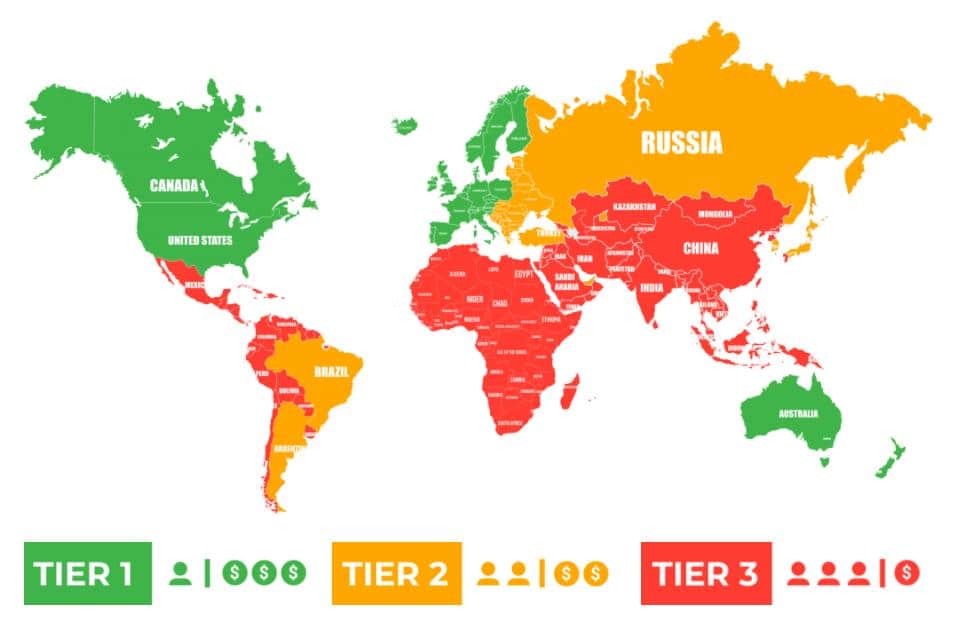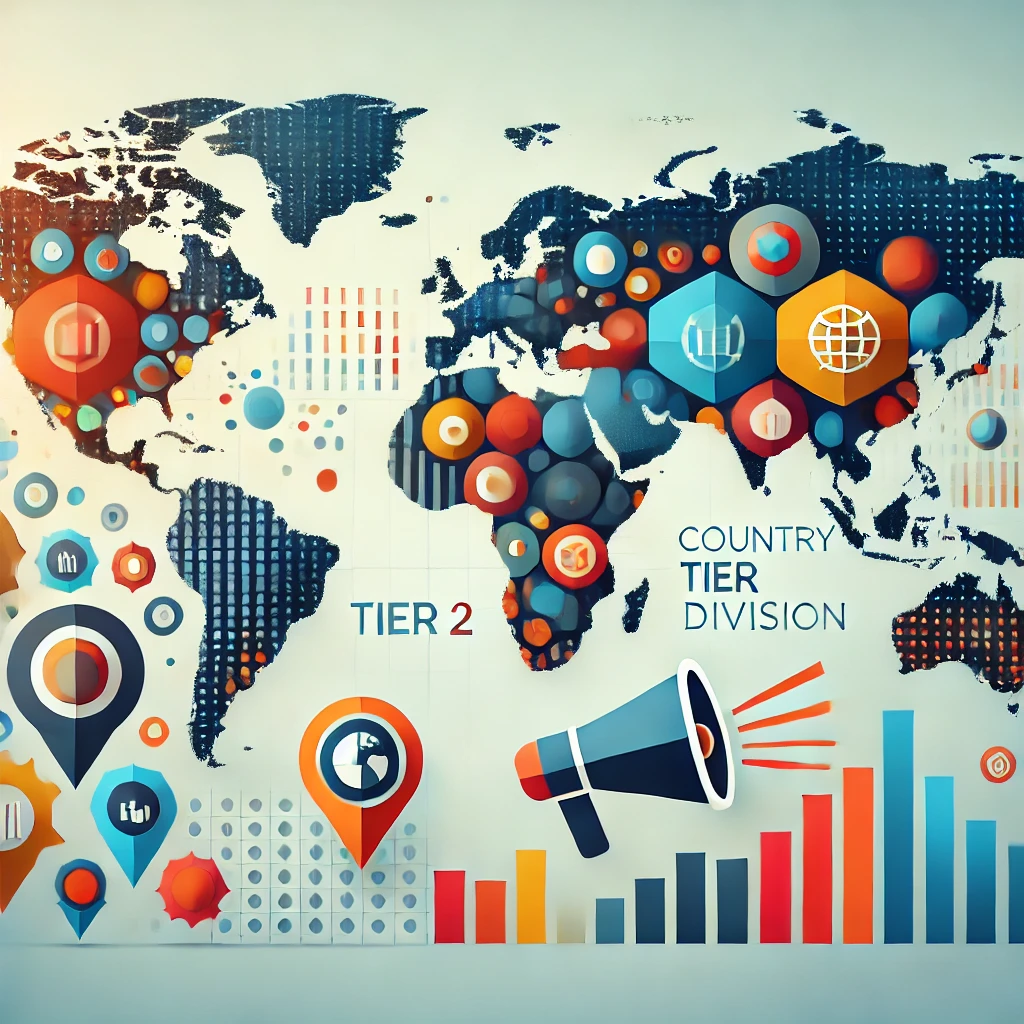Have you ever wondered how advertising campaigns are tailored to specific countries? Or why certain countries seem to receive more attention from marketers than others? In this article, we delve into the fascinating world of country tier division in advertising, aiming to demystify the concept and shed light on the number of tier divisions and the countries included in each.
Understanding the country tier division is crucial for marketers looking to expand their reach and maximize the effectiveness of their advertising campaigns. By categorizing countries into tiers, advertisers can better target their audience, allocate resources strategically, and tailor their messages to resonate with specific consumer behaviors and preferences.
Throughout this in-depth exploration, we will uncover the criteria used to determine country tiers, examine the number of divisions commonly used, and delve into the countries included in each tier. Whether you’re a seasoned marketer or just curious about the inner workings of the advertising industry, this article aims to provide valuable insights into the country tier division and its impact on advertising effectiveness.
Join us as we unlock the secrets behind successful international advertising campaigns and gain a deeper understanding of how countries are categorized to optimize marketing efforts.
Understanding the concept of country tiers
The concept of country tiers in advertising refers to the classification of countries based on specific criteria that influence marketing strategies. This classification system allows advertisers to group countries into different levels, or tiers, according to their economic status, market potential, consumer behavior, and digital connectivity. Generally, these tiers range from high to low, with Tier 1 countries representing those with the most lucrative market opportunities and advanced consumer bases, while lower tiers signify emerging or developing markets with different challenges and potentials.
There are three principal tiers in this system. Each tier reflects a country’s purchasing power, ad rates, and internet penetration levels.
Tier Divisions Include:
- Tier 1: High-income countries with robust digital engagement.
- Tier 2: Middle-income countries with emerging digital markets.
- Tier 3: Low-income countries with unique advertising challenges.

Tier 1 countries are seen as premium markets. They offer the highest returns on ad investments. Their robust economies and advanced digital landscapes are key factors.
Tier 2 countries are dynamic and promising. They show significant growth in internet users and digital activity. These countries are constantly evolving and offer opportunities for advertisers ready to innovate.
Tier 3 countries, although challenging, present a different kind of opportunity. These markets can be tapped into with cost-effective strategies and localized content. Understanding cultural nuances is crucial in these regions.
The tier system is not just about ad rates. It’s about strategizing effectively to target the right audience. Internet penetration and consumer behavior play crucial roles in determining a country’s tier status.
Understanding these tiers is essential for marketers seeking to expand their global footprint. By analyzing the specific characteristics and trends within each tier, businesses can tailor their advertising campaigns to meet the unique needs of different markets. This nuanced approach not only enhances the effectiveness of marketing strategies but also fosters a deeper connection with consumers, ultimately leading to higher engagement and conversion rates.
Why Country Tiers Matter in Advertising
Country tiers serve as essential frameworks for advertisers. Knowing a country’s tier helps in budget allocation and strategy development.
In high-tier countries, competition is intense, and ad rates are high. Advertisers focus on quality content and engaging user experiences.
In contrast, middle-tier countries offer a different scenario. They demand a balance between cost and creativity. Advertisers often experiment with local influencers and innovative formats.
Low-tier countries might not be a priority for all brands, but they should not be ignored. Tailoring ads to meet local needs can set a brand apart in these markets.
Therefore, country tiers guide advertisers in making informed decisions. They help maximize returns while minimizing risks in unfamiliar markets.
The Impact of Country Tiers on Ad Rates and Revenue
Ad rates and revenue vary considerably across different tiers. Tier 1 countries command the highest ad prices due to consumer spending power.
These high rates correspond with better revenue possibilities. Advertisers invest heavily in these markets, expecting substantial returns.
In Tier 2 countries, ad rates are moderate. However, the potential for growth is immense. Brands adopting innovative strategies can greatly benefit from these evolving markets.
Conversely, Tier 3 countries often have the lowest ad rates. The revenue potential is limited, but targeted strategies can yield satisfactory results.
Understanding the economic factors in each tier is critical. This knowledge helps advertisers optimize their campaigns, ensuring effective ROI across all tiers.
The importance of country tiers in advertising campaigns
Country tiers play a pivotal role in shaping advertising campaigns by providing a structured framework for targeting and resource allocation. Marketers can make informed decisions about where to focus their efforts based on the tiers assigned to different countries. For instance, a company launching a new product may prioritize Tier 1 countries for its initial campaign, where consumers are more likely to respond positively due to higher purchasing power and brand familiarity. This strategic focus allows for a more efficient use of marketing budgets and enhances the likelihood of achieving desired outcomes.
Moreover, understanding country tiers helps in the customization of messages and creative content. Each tier comes with its own cultural nuances, consumer behaviors, and preferences. Advertisers must craft tailored messages that resonate with the local audience, considering factors such as language, imagery, and cultural references. A campaign that works in a Tier 1 country may not yield the same results in a Tier 2 or Tier 3 country due to these differences, making tier awareness essential for successful international marketing.
Additionally, country tier divisions allow brands to track performance and adapt their strategies accordingly. By monitoring the effectiveness of campaigns in various tiers, marketers can gather valuable data that informs future initiatives. This iterative process of analysis and adjustment is crucial for maintaining relevance in rapidly changing markets, ensuring that advertising efforts are continually optimized to meet consumer needs.
The Three Tiers of Advertising: A Detailed Overview
Understanding the three tiers of advertising is vital for digital marketers. Each tier represents a unique set of opportunities and challenges.
The tier system categorizes countries based on economic status, digital development, and consumer behavior. Tier 1 countries boast advanced economies and tech-savvy populations.
Tier 2 countries are on the rise, showing considerable economic progress and increasing digital presence. Tier 3 countries, however, are still developing, with specific challenges such as lower income levels and limited internet access.
Tailoring strategies to suit each tier ensures advertisers can effectively reach their target audiences. This targeted approach can vastly improve advertising efficiency and success.

Tier 1 Countries: The Most Lucrative Markets
Tier 1 countries are like the gold mines of global advertising, thanks to their high-income economies, tech-savvy populations, and big spending power. These markets are attractive because they’re full of people who not only have the money but are also ready to engage with digital content and shop online.
Advertisers love Tier 1 countries because they offer high returns. Cost-per-click (CPC) rates are generally higher, but so are the conversion rates. With an audience that’s more likely to buy, brands put extra budget toward these markets, focusing on quality, targeted content that meets the high standards of discerning consumers.
These countries have a high level of digital literacy, which is both a plus and a challenge. People here are used to digital content, so advertisers need to get creative to stand out. Because tech adoption is so widespread, many brands use AI and machine learning to make their campaigns even sharper and more efficient.
Yes, the ad costs are high in Tier 1 countries, but the return on investment (ROI) usually justifies the spend. Audiences in these regions are not only more likely to engage but also tend to spend more.
Advertisers need to keep a few key factors in mind, like stricter data privacy rules. Staying compliant is essential for keeping a positive brand image and avoiding any legal troubles.
Localization is also important—translating and adjusting content to fit local cultures goes a long way in building a connection with these audiences.
Many global brands use Tier 1 markets to test out new ideas, from virtual reality (VR) to augmented reality (AR), because people here are ready to try out the latest tech.
Mobile advertising is especially effective in these countries, with many consumers browsing and buying on their phones. That’s why mobile-first ad strategies tend to perform well in these regions.
Influencers and content creators also play a major role. Partnering with popular local figures can give brands a big boost in reaching and connecting with audiences.
Social media is another powerful tool, with platforms like Instagram and Facebook often producing great engagement when campaigns are tailored to the audience’s preferences.
Data and analytics are critical to success in these markets. Marketers dig into data to understand trends and consumer habits, allowing them to fine-tune their campaigns for maximum impact.
One challenge to keep in mind is ad blockers. Brands need to create non-intrusive, valuable content that feels relevant to the audience to ensure their ads get seen.
Finally, brand safety and a solid reputation are essential in Tier 1 countries. Advertisers need to make sure their messages align with the brand’s values and meet consumer expectations.
Tier 1 Countries List
- United States
- Canada
- United Kingdom
- Germany
- Australia
- France
- Japan
- New Zealand
- Switzerland
- Norway
In summary, Tier 1 countries offer incredible opportunities for advertisers willing to invest. With smart, localized strategies, brands can achieve high returns and connect deeply with these premium markets.
Tier 2 Countries: Emerging Markets with Potential
Tier 2 countries are exciting markets with a lot of growth potential. While they don’t have the same income levels as Tier 1 countries, they’re developing quickly in the digital space, making them ripe for advertisers to explore new strategies and reach an expanding audience.
These regions have a growing middle class and a rising number of internet users. Although advertising costs are generally lower here than in Tier 1 countries, advertisers can still see great returns with a well-planned approach.
One of the keys to success in Tier 2 countries is localization. Understanding local cultures and tailoring campaigns accordingly can significantly increase engagement. This is especially important as e-commerce continues to grow, giving brands more chances to reach online shoppers.
Social media is widely used in these regions, providing an ideal platform for brands to build awareness and drive engagement. Mobile technology is also big here, so mobile advertising is becoming essential for connecting with audiences effectively.
Influencer marketing is on the rise, too. Partnering with local influencers can add credibility to campaigns and help brands connect with consumers on a more personal level.
Language and localization go beyond just being helpful—they’re often crucial. Advertising in the local language helps build trust and makes campaigns feel more relevant to the audience.
Economically, these countries show promise for future growth, with some on track to potentially reach Tier 1 status. Digital literacy is also improving, which means brands have opportunities to use educational content to engage and inform audiences.
Using data and analytics is crucial in Tier 2 markets. By understanding consumer behavior and preferences, advertisers can refine their strategies to be more effective.
There are, however, challenges. Consumers in Tier 2 countries can be price-sensitive, so brands need to find the right balance between cost and value. Economic ups and downs can also impact advertising success, so staying updated on local market trends is essential.
Regulations in these regions can be complex. Advertisers need to be aware of local advertising standards to stay compliant and protect their reputation.
As digital payments continue to evolve, brands should make sure their platforms support easy transactions to boost conversion rates.
List of Tier 2 Countries
- Brazil
- India
- China
- Mexico
- South Africa
- Indonesia
- Russia
- Turkey
- Malaysia
- Thailand
In summary, Tier 2 countries offer exciting growth opportunities for brands willing to adapt. With a smart, localized approach, advertisers can build strong connections and see impressive returns in these developing markets.
Tier 3 Countries: Challenges and Opportunities
Tier 3 countries offer unique challenges and opportunities for advertisers. These regions often have lower income levels and limited digital infrastructure, which can affect the reach and effectiveness of digital ads. However, as connectivity improves, there’s potential for growth and engagement in these markets.
Internet access may still be limited in these countries, but it’s steadily expanding. With ad rates typically being the lowest here, advertisers can test cost-effective strategies without breaking the bank.
Success in Tier 3 markets often depends on cultural relevance. Understanding local customs and societal values helps brands connect with audiences in meaningful ways. Crafting affordable and value-focused campaigns can also be effective, as consumers here tend to have lower purchasing power.
Social media is gradually growing in popularity. With platforms becoming more accessible, advertisers can use these networks to reach new audiences as they come online.
Digital literacy levels vary, so educational content often performs well. Ads that explain products or services in simple terms can build trust and help consumers make informed decisions.
Tier 3 countries also come with regulatory complexities. Advertisers must pay close attention to local advertising laws to ensure compliance and avoid potential issues.
Consumer behavior in these regions is diverse, which makes market research essential. Knowing the specific needs and preferences of these audiences allows brands to better tailor their campaigns.
Traditional media, such as radio or print, is still widely used and can complement digital ads for broader reach. In these markets, combining traditional and digital media can help brands maximize engagement.
Simple, straightforward messaging usually works best. Ads that are easy to understand are more likely to resonate with these audiences.
Forming partnerships with local businesses can also boost credibility. Collaborative campaigns can make brands feel more familiar and accepted.
Although there are challenges, there’s also opportunity for growth as these economies develop. Many Tier 3 countries have the potential to move up the ranks, offering long-term prospects for brands willing to invest now.
Digital infrastructure investments are accelerating, so advertisers should keep an eye on future potential. The increased use of mobile phones also highlights the importance of mobile-friendly ads for effective engagement.
E-commerce is still in its early stages, and payment systems may not be fully developed. Brands should consider offering easy payment options to improve conversions and reach more consumers.
Building community connections is key to fostering brand loyalty in these markets. Engaging with local communities helps build trust and strengthens brand affinity.
List of Tier 3 Countries
- Nigeria
- Kenya
- Bangladesh
- Pakistan
- Vietnam
- Philippines
- Morocco
- Egypt
- Ghana
- Argentina
In summary, Tier 3 countries provide a unique landscape for advertisers. With an understanding of local cultures, an emphasis on affordability, and a focus on future potential, brands can establish a foothold in these emerging markets and build lasting relationships with new audiences.
Advantages of advertising in higher tier countries
Advertising in higher tier countries offers several distinct advantages that can significantly enhance the effectiveness of marketing campaigns. One of the primary benefits is the higher purchasing power of consumers in these regions. With greater disposable income, consumers in Tier 1 countries tend to spend more on luxury and premium products, making it easier for advertisers to achieve substantial returns on their investments. This financial capability allows brands to implement more ambitious and creative marketing strategies.
Another advantage is the advanced digital infrastructure present in higher tier countries. These nations typically have widespread internet connectivity, high smartphone penetration, and a robust e-commerce ecosystem. This digital landscape enables advertisers to leverage various online marketing channels, including social media, search engine marketing, and influencer partnerships, to reach their target audience effectively. The ability to utilize data analytics and targeted advertising further enhances the potential for successful campaigns in these markets.
Higher tier countries also often have well-established advertising regulations and practices, providing a more predictable environment for marketers. This stability allows brands to plan their campaigns with greater confidence, knowing they can navigate the regulatory landscape effectively. Furthermore, the presence of numerous advertising agencies and professionals with expertise in these markets enables companies to access valuable insights and creative talent, fostering collaboration and innovation in their marketing efforts.
Challenges and opportunities in lower tier countries
While advertising in lower tier countries presents challenges, it also offers unique opportunities for brands willing to invest in understanding these markets. One of the primary challenges faced by advertisers in Tier 2 and Tier 3 countries is the lower purchasing power of consumers. This economic limitation necessitates cost-effective marketing strategies and often requires brands to adjust their product offerings to cater to budget-conscious consumers. However, this constraint can also lead to innovation, as advertisers find creative ways to deliver value and engage with audiences on a budget.
Another challenge is the diverse cultural landscape in lower tier countries. These nations often comprise a mosaic of languages, traditions, and consumer behaviors, making it imperative for marketers to tailor their messages accordingly. Failing to recognize and respect these differences can result in campaigns that miss the mark or even offend the target audience. Yet, this cultural diversity presents an opportunity for brands to develop localized marketing campaigns that resonate deeply with consumers, fostering loyalty and connection.
Moreover, lower tier countries frequently experience rapid economic growth and increasing access to technology. As these markets develop, they can offer significant potential for advertisers willing to invest time and resources. Engaging with emerging consumers who are becoming increasingly connected presents a chance for brands to establish early footholds in these regions. By understanding local needs and preferences, advertisers can create campaigns that not only resonate with consumers but also position their brands as leaders in developing markets.
Strategies for targeting specific country tiers
To effectively target specific country tiers, marketers must employ tailored strategies that consider the unique characteristics of each tier. For Tier 1 countries, a focus on premium branding and high-quality content is essential. Advertisers should invest in creating visually appealing, emotionally resonant campaigns that highlight product quality and brand prestige. Utilizing advanced digital marketing techniques, such as programmatic advertising and personalized content, can enhance engagement and drive conversions in these competitive markets.
When targeting Tier 2 countries, marketers should emphasize value and adaptability. Given the growing middle class in these regions, strategies that showcase affordability while maintaining quality can resonate well with consumers. It’s also crucial to leverage local influencers and partnerships to build credibility and trust among audiences. Additionally, adopting a multi-channel approach that incorporates both online and offline advertising can help reach diverse demographics in these emerging markets.
For Tier 3 countries, a grassroots approach may yield the best results. Marketers should prioritize community engagement and localized messaging to connect with consumers on a personal level. This might involve collaborating with local organizations, utilizing local languages, and understanding cultural nuances to create relevant and relatable campaigns. Social media can be a powerful tool in these regions, as it allows brands to engage directly with consumers and foster a sense of community around their products.
Conclusion: Leveraging country tier division for effective advertising
In conclusion, understanding and leveraging country tier divisions is crucial for marketers aiming to optimize their advertising strategies across global markets. By recognizing the unique characteristics and challenges associated with each tier, advertisers can tailor their campaigns to meet the specific needs and preferences of diverse consumer segments. This targeted approach not only enhances the effectiveness of marketing efforts but also fosters deeper connections with audiences.
As the global marketplace continues to evolve, the importance of country tier divisions will only increase. Marketers must stay attuned to the changing dynamics within these tiers, adjusting their strategies to capitalize on emerging opportunities while navigating potential challenges. By doing so, they can position their brands for success in an increasingly competitive advertising landscape.
Ultimately, the insights gained from understanding country tiers can equip marketers with the tools they need to create impactful campaigns that resonate with consumers around the world. As they unlock the secrets behind successful international advertising, they can drive engagement, foster loyalty, and achieve their business objectives on a global scale.











